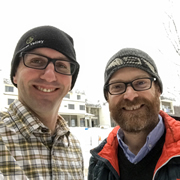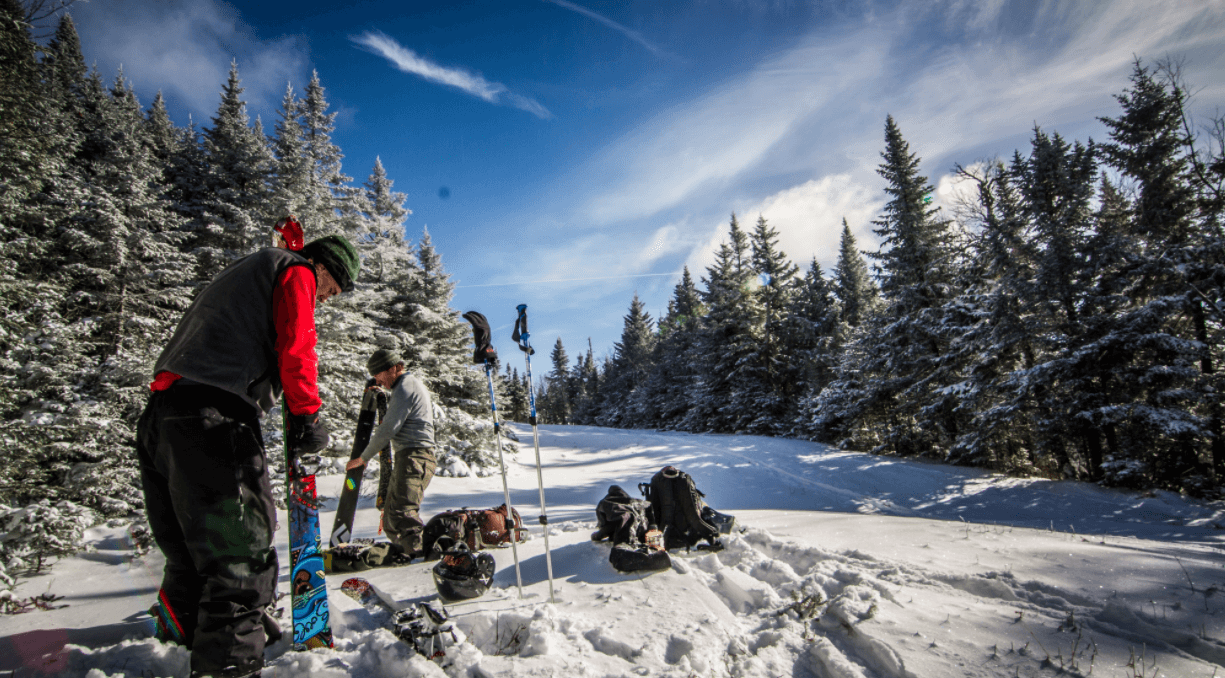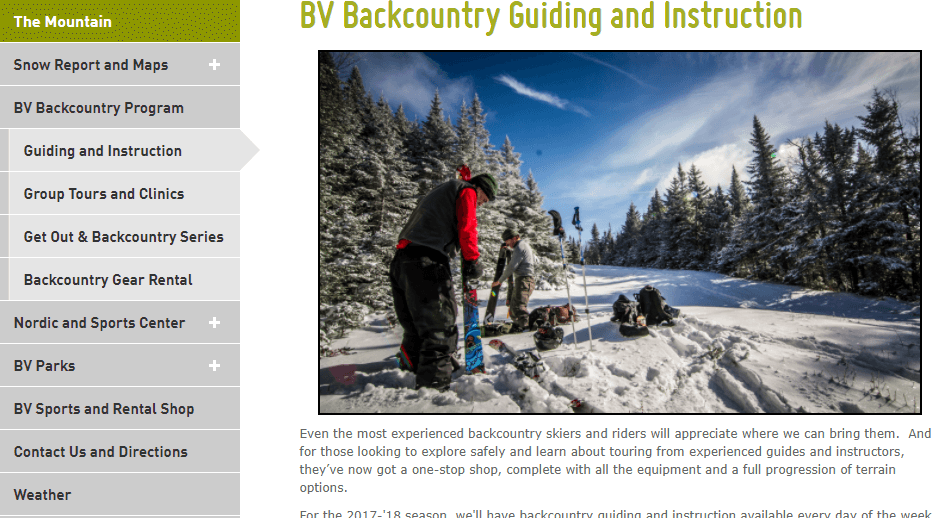
JOSH ARNESON & ADAM DESLAURIERS
Filling rooms with backcountry skiers…in Vermont.
The explosion in backcountry skiing typically triggers thoughts of The Sierra or Rockies, but the popularity is growing just as quickly on the opposite coast. With backcountry terrain within walking-distance of their lifts, Bolton Valley is quickly finding success catering to this group with new products, programs, and rentals.

Photo: Ryan Denning

BLANCHARD
Gregg: Josh, give me a little background on Bolton’s location, topography, and why it’s such a perfect fit for a backcountry product like this?
Josh Arneson: Backcountry skiing goes back to the roots of Bolton Valley. Edward Bryant started skiing this land in 1922, well before the first lifts opened in 1966. As the name implies, resort is actually in a valley. The resort grew with lift served skiing on one side of the valley, while the opposite side remained untouched backcountry offering over 1200 acres of terrain.
The mountain is just 30 minutes to Burlington making the backcountry easily accessible to locals. In addition, all the lodging at the resort is walking distance to the lifts and to the backcountry trailhead. With the new programs we aim to open accessibility to the backcountry.
Gregg: And the people? What’s the clientele like?
Josh Arneson: Many people have never tried backcountry skiing, but would like to, and others have dabbled but know they need more pointers. Our Saturday educational programs are geared toward these skiers. Sunday will be a longer tour open to anyone and should be attractive to folks who are experienced in the backcountry but who would like a guided introduction to the land.
We have already seen people booking vacations with us because they can have a convenient and educational backcountry experience while still being able to spend some time riding lifts, all while sleeping in a hotel that is walking distance to both.
Gregg: Adam, talk a little more about this. You’ve been skiing Bolton for a long time. What’s your perspective on Bolton’s backcountry scene?
Adam DesLauriers: I’ve definitely been skiing Bolton for a long time. Though I have to confess that during my twenties, when I was personally discovering backcountry skiing, I was actually living in Lake Tahoe, California. So the growing interest in it that I was witnessing at first, was basically in line with my own motives – in that there was clearly so much more beautiful terrain to be explored and skied beyond alpine ski area boundaries. As it became possible to travel in the backcountry with equipment that didn’t substantially affect downhill performance, it was a no-brainer for me that’s where I wanted to go.
So when I moved back to Vermont full time and started having kids around 2003/2004, I had the equipment and I knew the area, so I jumped into it here at Bolton Valley to then discover that there were a surprising number of passionate backcountry skiers and riders all over the place in Vermont too. And it’s for pretty much all the same reasons I got interested in the backcountry as well. The skiing was great!
Are you looking to explore the backcountry? Inexperienced or don't know where to start? Check out our newly redesigned backcountry programs including guiding services and see where we may be able to help you. #foundatbv https://t.co/HQj7MOk3fY pic.twitter.com/sLwHIQ0vjr
— Bolton Valley (@BoltonValley) December 20, 2017
Gregg: What makes now the right time to start this?
Adam DesLauriers: There was always a passion around Bolton for cutting and maintaining great backcountry terrain when Gardiner Lane and his crew were forging through the wilderness in the late ’60’s into the early ’90’s – a legacy that still totally thrives among the “Friends of Bolton Valley Nordic and Backcountry” organization. But in my opinion, the growth in popularity has come with technological advancements in touring equipment during the past 20 years especially. It’s appealing to a different and larger market that is more experienced alpine skiers and snowboarders looking to get to different terrain in exciting locations. As that interest has grown, so has the visibility of the sport and therefore the appeal to less experienced alpine skiers and riders.
The equipment I just ordered literally day before yesterday for our Dynafit demo and rental center is lighter, more stable and supportive, and with pivoting toe-pieces and proper DIN settings, safer than anything up to this point.
Gregg: Gear opportunities aside, Adam, does the lack of avalanche danger and other concerns create more opportunities for safe backcountry skiing than in the west?
Adam DesLauriers: Here at Bolton though, we have zero avalanche danger because all our backcountry is heavily forested. If just the right conditions exist, there could be some sluffing or settling in some of the steeper chutes, but there’s just not enough open area or sustained pitch for any real amount of snow to build enough mass or momentum to be dangerous. So in that sense, yes, it’s definitely safer to go in the backcountry in many parts of the east.
However, there are other dangers unique to forested areas. Especially in less managed backcountry areas, there could be the possibility of downed trees lying across what would otherwise be a nice open glade. Lodging a ski underneath one of those can and has resulted in boot-top fractures or even busted femurs in worse cases. And that’s when you run into probably the biggest concern for us in Vermont and the Northeast especially, which is the cold.
Gregg: What do you do to address that aspect?
Adam DesLauriers: Clothing and other preparations for cold weather are definitely a big part of what we try to account for safety-wise. Personally, I just keep my gore-tex bivy and an extra down jacket in my pack always. The temperatures can drop fast and dramatically in Vermont and it’s surprisingly easy to get lost. Cell coverage is never a sure thing, it’s usually difficult to see the lay of the land because you’re mostly in the trees, and the Green Mountains are made up of lots of steep narrow valleys that make them tricky to navigate. Many times, between the cloud coverage and the trees, it’s hard to even tell where the sun is in the sky.
Gregg: Adam, talk a little bit more about the difference between East and West. You fell in love with backcountry in Tahoe even though you’d grown up at Bolton.
Adam DesLauriers: One thing I can say with absolute certainty is that East Coast backcountry skiers are as psyched about it as West Coasters are. There’s certainly no denying that east coast terrain and west coast terrain are different. We don’t have open faces and big high peaks backed up one after the other. So obviously some folks will point that out when comparing the two. But we have plenty of steeps and drops and technical terrain that can challenge anyone. And in the backcountry especially, we have beautiful snow and lots of it.
As the backcountry movement keeps growing in the East, and more people are committed to making it available, we’ve also got more terrain to choose from every year. So while it isn’t the same as summiting a 14000’ peak and getting a 6000’ descent, it’s definitely strikingly beautiful and it’s great skiing and it’s right here in our back yard.
Gregg: Josh, talk a bit more about rentals. Does that perception impact how many people have or buy their own gear? How big of a role are rentals in getting people in the backcountry?
Josh Arneson: There is a core set of people that have their own backcountry touring gear. But, there is also a population of people who would like to try backcountry skiing before they commit to purchasing equipment. Until this season our on-site backcountry rental fleet was pretty limited. The addition of new equipment from Dynafit will allow the alpine skier to more easily transition to backcountry equipment, right on site. Our goal is to reduce the friction and increase trial of the sport of backcountry skiing, providing quality rental equipment that is available onsite, coupled with introductory classes will help us achieve that goal.
Gregg: When you look at this program, what kind of opportunities do you see for actually driving revenue for the resort?
Josh Arneson: Skiers looking to access our terrain need either a Nordic season pass or a Nordic day ticket, and we have a core base of folks who have been accessing our terrain this way for years. The addition of educational programs, tours, and rental equipment opens the experience up to more people.
The tours are great for established backcountry skiers who just want to become more familiar with the land. The educational programs and rental equipment allow novice backcountry skiers to try it out. We’ll see direct revenue from all of these programs. We have already booked some vacations where access to these programs was the motivating factor. In addition to people solely motivated by these programs we expect to see an increased trial rate from both locals and overnight guests.
We view the access that we provide to backcountry terrain coupled with the programs, tours, and rentals as a unique selling point for Bolton Valley. Because this is an experience that is not offered by any of our competitors in quite the same way, we feel we have a great opportunity to set Bolton apart.
About Gregg & SlopeFillers
I've had more first-time visitors lately, so adding a quick "about" section. I started SlopeFillers in 2010
with the simple goal of sharing great resort marketing strategies. Today I run marketing for resort ecommerce and CRM provider
Inntopia,
my home mountain is the lovely Nordic Valley,
and my favorite marketing campaign remains the Ski Utah TV show that sold me on skiing as a kid in the 90s.
Get the weekly digest.
New stories, ideas, and jobs delivered to your inbox every Friday morning.

